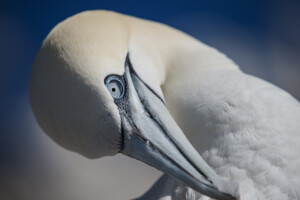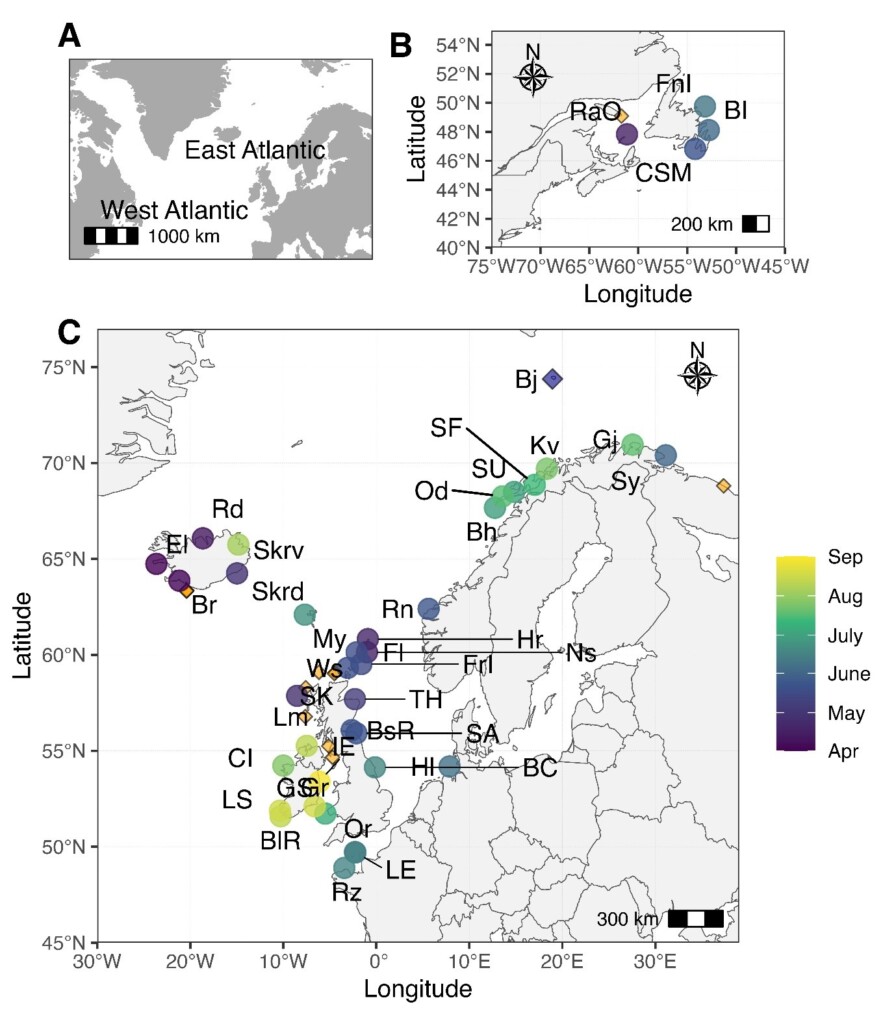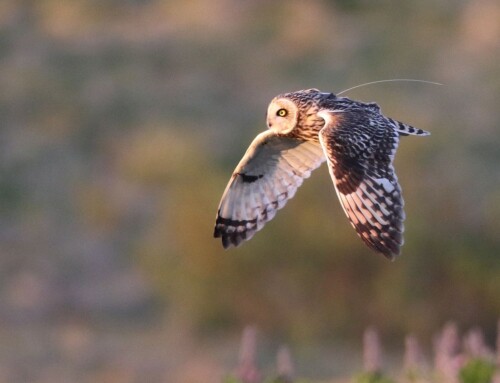
LINKED PAPER
High pathogenicity avian influenza (H5N1) in Northern Gannets (Morus bassanus): Global spread, clinical signs and demographic consequences. Lane, J.V., Jeglinski, J.W., Avery‐Gomm, S., Ballstaedt, E., Banyard, A.C., Barychka, T., Brown, I.H., Brugger, B., Burt, T.V., Careen, N., Castenschiold, J.H., Christensen-Dalsgaard, S., Clifford, S., Collins, S.M., Cunningham, E., Danielsen, J., Daunt, F., D’entremont, K., Doiron, P., Duffy, S., English, M.D., Falchieri, M., Giacinti, J., Gjerset, B., Granstad, S., Grémillet, D., Guillemette, M., Hallgrímsson, G.T., Hamer, K.C., Hammer, S., Harrison, K., Hart, J.D., Hatsell, C., Humpidge, R., James, J., Jenkinson, A., Jessopp, M., Jones, M., Lair, S., Lewis, T., Malinowska, A.A., McCluskie, A., McPhail, G., Moe, B., Montevecchi, W.A., Morgan, G., Nichol, C., Nisbet, C., Olsen, B., Provencher, J., Provost, P., Purdie, A.,Rail, J., Robertson, G., Seyer, Y., Sheddan, M., Soos, C., Stephens, N., Strøm, H., Svansson, V., Tierney, D., Tyler, G., Wade, T., Wanless, S., Ward, C., Wilhelm, S.I., Wischnewski, S., Wright, L.J., Zonfrillo, B., Matthiopoulos, J., Votier, S.C. 2023. IBIS. DOI:10.1111/ibi.13275 VIEW
Bass Rock is the world’s largest Northern Gannet colony. It makes an assault on every sense – the visual spectacle, the noise, and of course the smell! Sitting just 2.5km off the coast of East Lothian, 30 miles east of Edinburgh, this Scottish island stands out like an ethereal beacon with a haze of tiny white specs just visible over the summit, returning and departing birds a constant presence overhead.
When our research team left the island for the last time in the summer of 2021, the colony was a bursting, thriving seabird city. One year later, the Bass Rock colony was devastated by Avian Influenza.

Figure 1. Bass Rock: top – a busy and healthy colony in July 2021; bottom – devastated by HPAI in July 2022 © Jude Lane.
High Pathogenicity Avian Influenza Virus (HPAIV) – a novel virus in seabirds
Avian Influenza Viruses (AIVs) circulate naturally in bird populations. High Pathogenicity Avian Influenza virus (HPAIV) H5N1 was first detected on a domestic goose farm in Southern China in 1996. Since then, it has evolved and spread across Asia, Africa, the Middle East, and Europe causing significant outbreaks in a variety of bird populations (European Food Safety Authority et al. 2023). In the UK, the first detections of a new H5N1 virus, occurred over the winter period of 2020-21. The first incursion of this HPAIV into seabirds was detected when a large number of Great Skua, an already vulnerable species of conservation concern, were infected and died during the summer of 2021 (Banyard et al. 2022). In 2022, HPAIV was catapulted into the public consciousness in the UK due to the unprecedented impact it was having on wild birds. Thousands of seabirds were dying at their colonies and washing up on beaches around the coastline. One of the hardest hit species was the Gannet.
The challenge and global impact
Monitoring seabirds is always challenging as they tend to breed in remote and difficult to access locations. Gannets are certainly no exception. Working during a HPAIV outbreak increased the challenge due to the additional protocols needed to safeguard fieldworkers and to prevent spread of the virus within and between colonies and species. However, despite the challenges, seabird researchers did all they could to study the impacts on Gannets. We collated information from across the global network of research teams. This confirmed HPAIV outbreaks at 40 of the 53 Gannet colonies, spanning from North-East Canada to France to North-East Norway, between April and September 2022.

Figure 2. The timing of HPAIV outbreaks across the Gannet meta-population in 2022, based on the first date unusual mortalities in adults were observed. Affected colonies (n = 40) are indicated by circles, coloured by date. Colonies where information was unavailable (n = 12) are indicated by open diamonds. A) Geographical context; B) colonies in the west Atlantic; C) colonies in the east Atlantic. A filled diamond indicates Bjørnøya (Bj, Norway, the northernmost colony) where no signs of HPAIV were observed.
Immunity and reason for hope
Whilst it was clear that many thousands of Gannets were dying, questions quickly arose regarding whether there were any individuals in infected colonies that had avoided catching the virus, or that caught the virus but survived. Mortality rates of infected individuals of some species, such as chickens, is known to be very high but nothing was known about the susceptibility of Gannets.
Days after the virus was known to be present at Bass Rock, we started seeing Gannets with unusual iris colouring; ranging from mottled to completely black. Gannets normally have piercing pale blue/grey eyes, so the black eyes were very conspicuous and something no-one had seen before. The combination of birds with black eyes being seen for the first time during the first known outbreak of HPAIV, led us to suspect that the black iris colouring was linked to infection.

Figure 3. Gannets on the Bass Rock colony in 2022 with black flecking in their irises. The condition was variable between individuals from a) healthy, b and c) increasing degrees of black flecks in the iris d) completely black iris, and asymmetrical irises affected to e) greater and f) lesser extents. No pattern was detected in the asymmetry of black irises.
Benefiting from having a group of birds within the colony previously marked with uniquely coded leg rings, we could monitor the survival of black-eyed birds during and after the outbreak. A symptomatic black-eyed bird was subsequently found dead in Denmark, whereas other black-eyed birds were seen alive and seemingly well at the colony throughout the summer. This was encouraging as it could mean that some individuals were able to survive infection.

Figure 4. Colour-ringed Gannet with unique identification code © Jude Lane.
Analysis of blood samples taken from Gannets with black and normal eyes confirmed our suspicion. Seventy eight percent of black-eyed birds had antibodies to H5N1 showing that development of black in the iris is highly likely to be linked to a previous HPAI infection. Antibody responses to HPAIVs are poorly understood in wild birds. We hope our work will continue to inform our understanding of this HPAIV subtype and how the Gannet population will respond to the 2022 and possible future outbreaks. If black eyes can be used for monitoring recovered and now immune individuals, this has important implications for population modelling. For example, understanding potential impacts of the virus on breeding productivity and longer-term survival.
Securing a future for seabirds
Seabirds are under massive pressure from climate change, lack of prey fish, entanglement in fishing gear, predation by non-native invasive species and developments along our coasts. The Seabirds Count 2015-2021 revealed revealed that almost half of species that regularly breed in Britain and Ireland have declined over the past 20 years (Burnell et al. 2023). This outbreak has highlighted HPAIV as an additional and major human-generated threat to seabirds. We urgently need to implement actions for our vulnerable seabirds to ensure robust populations that are resilient to all the pressures we are placing on them.
Northern Gannets are currently classified as Least Concern for their conservation status by the IUCN. The UK Gannet population grew between 2015-2021 (Burnell et al. 2023). A number of the larger colonies such as Bass Rock and Grassholm, Wales are known to have suffered high mortality from the 2022 HPAIV outbreak, however it is still not know what the impact of the outbreak has been on the UK population. Even for such species that currently appear to be doing well, there should be no complacency in putting into place long-term monitoring, research, and response plans so that they can continue to thrive.
References
Banyard, A.C., Lean, F.Z.X., Robinson, C., Howie, F., Tyler, G., Nisbet, C., Seekings, J., Meyer, S., Whittard, E., Ashpitel, H.F. 2022. Detection of Highly Pathogenic Avian Influenza Virus H5N1 Clade 2.3.4.4b in Great Skuas: A Species of Conservation Concern in Great Britain. Viruses 14:212. VIEW
Burnell, D., Perkins, A.J., Newton, S.F., Bolton, M., Tierney, T.D., Dunn, T.E. 2023. Seabirds Count: A census of breeding seabirds in Britain and Ireland (2015-2021). Lynx Edicons ISBN: 9788416728602. VIEW
European Food Safety Authority, European Centre for Disease Prevention and Control, European Reference Laboratory for Avian Influenza, Adlhoch, C., Fusaro, A., Gonzales, J.L., Kuiken, T., Marangon, S., Niqueux, E., Staubach, C., Terregino, C., Aznar, I., Munoz Guajardo, I., Baldinelli, F. 2023. Scientific report: Avian influenza overview September– December 2022. European Food Safety Authority Journal 21:7786. VIEW
Image credits
Top right: The eyes of Gannets are usually pale blue-grey © Sam Hobson.
Blog posts express the views of the individual author(s) and not those of the BOU.
If you want to write about your research in #theBOUblog, then please see here.




